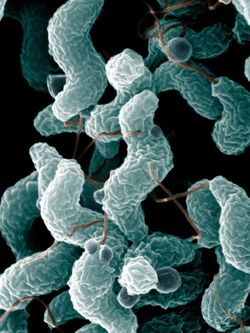Biology:Campylobacterota
| Campylobacterota | |
|---|---|

| |
| Campylobacter | |
| Scientific classification | |
| Domain: | Bacteria |
| Phylum: | Campylobacterota Waite et al. 2021[1] |
| Classes | |
| |
| Synonyms | |
| |
Campylobacterota are a phylum of bacteria.[3] All species of this phylum are Gram-negative.
The Campylobacterota consist of few known genera, mainly the curved to spirilloid Wolinella spp., Helicobacter spp., and Campylobacter spp. Most of the known species inhabit the digestive tracts of animals and serve as symbionts (Wolinella spp. in cattle) or pathogens (Helicobacter spp. in the stomach, Campylobacter spp. in the duodenum). Many Campylobacterota are motile with flagella.[4]
Numerous environmental sequences and isolates of Campylobacterota have also been recovered from hydrothermal vents and cold seep habitats. Examples of isolates include Sulfurimonas autotrophica,[5] Sulfurimonas paralvinellae,[6] Sulfurovum lithotrophicum[7] and Nautilia profundicola.[8] A member of the phylum Campylobacterota occurs as an endosymbiont in the large gills of the deepwater sea snail Alviniconcha hessleri.[9]
The Campylobacterota found at deep-sea hydrothermal vents characteristically exhibit chemolithotrophy, meeting their energy needs by oxidizing reduced sulfur, formate, or hydrogen coupled to the reduction of nitrate or oxygen.[10] Autotrophic Campylobacterota use the reverse Krebs cycle to fix carbon dioxide into biomass, a pathway originally thought to be of little environmental significance. The oxygen sensitivity of this pathway is consistent with their microaerophilic or anaerobic niche in these environments, and their likely evolution in the Mesoproterozoic oceans,[11] which are thought to have been sulfidic with low levels of oxygen available from cyanobacterial photosynthesis.[12]
Phylogeny
The currently accepted taxonomy is based on the List of Prokaryotic names with Standing in Nomenclature (LPSN)[13] and National Center for Biotechnology Information (NCBI)[14]
| 16S rRNA based LTP_08_2023[15][16][17] | 120 single copy marker proteins based GTDB 08-RS214[18][19][20] | ||||||||||||||||||||||||||||||||||||||||||||||||||||||||||||||||||||||||||||||||||||||||||||||||||||||||||||||||||||||||||||||||||||||||||||||||||||||
|---|---|---|---|---|---|---|---|---|---|---|---|---|---|---|---|---|---|---|---|---|---|---|---|---|---|---|---|---|---|---|---|---|---|---|---|---|---|---|---|---|---|---|---|---|---|---|---|---|---|---|---|---|---|---|---|---|---|---|---|---|---|---|---|---|---|---|---|---|---|---|---|---|---|---|---|---|---|---|---|---|---|---|---|---|---|---|---|---|---|---|---|---|---|---|---|---|---|---|---|---|---|---|---|---|---|---|---|---|---|---|---|---|---|---|---|---|---|---|---|---|---|---|---|---|---|---|---|---|---|---|---|---|---|---|---|---|---|---|---|---|---|---|---|---|---|---|---|---|---|---|---|
|
|
See also
References
- ↑ "Valid publication of the names of forty-two phyla of prokaryotes". Int J Syst Evol Microbiol 71 (10): 5056. 2021. doi:10.1099/ijsem.0.005056. PMID 34694987.
- ↑ Waite, David W.; Vanwonterghem, Inka; Rinke, Christian; Parks, Donovan H.; Zhang, Ying; Takai, Ken; Sievert, Stefan M.; Simon, Jörg et al. (2017). "Comparative Genomic Analysis of the Class Epsilonproteobacteria and Proposed Reclassification to Epsilonbacteraeota (phyl. nov.)". Frontiers in Microbiology 8: 682. doi:10.3389/fmicb.2017.00682. ISSN 1664-302X. PMID 28484436.
- ↑ "www.ncbi.nlm.nih.gov". https://www.ncbi.nlm.nih.gov/Taxonomy/Browser/wwwtax.cgi?mode=Info&id=29547.
- ↑ Beeby, M (December 2015). "Motility in the epsilon-proteobacteria.". Current Opinion in Microbiology 28: 115–21. doi:10.1016/j.mib.2015.09.005. PMID 26590774.
- ↑ Inagaki, F. (2003-11-01). "Sulfurimonas autotrophica gen. nov., sp. nov., a novel sulfur-oxidizing -proteobacterium isolated from hydrothermal sediments in the Mid-Okinawa Trough". International Journal of Systematic and Evolutionary Microbiology 53 (6): 1801–1805. doi:10.1099/ijs.0.02682-0. ISSN 1466-5026. PMID 14657107.
- ↑ Takai, K. (2006-08-01). "Sulfurimonas paralvinellae sp. nov., a novel mesophilic, hydrogen- and sulfur-oxidizing chemolithoautotroph within the Epsilonproteobacteria isolated from a deep-sea hydrothermal vent polychaete nest, reclassification of Thiomicrospira denitrificans as Sulfurimonas denitrificans comb. nov. and emended description of the genus Sulfurimonas". International Journal of Systematic and Evolutionary Microbiology 56 (8): 1725–1733. doi:10.1099/ijs.0.64255-0. ISSN 1466-5026. PMID 16901999.
- ↑ Inagaki, Fumio; Ken Takai; Kenneth H. Nealson; Koki Horikoshi (2004-09-01). "Sulfurovum lithotrophicum gen. nov., sp. nov., a novel sulfur-oxidizing chemolithoautotroph within the ε-Proteobacteria isolated from Okinawa Trough hydrothermal sediments". International Journal of Systematic and Evolutionary Microbiology 54 (5): 1477–1482. doi:10.1099/ijs.0.03042-0. ISSN 1466-5026. PMID 15388698.
- ↑ Julie L. Smith; Barbara J. Campbell; Thomas E. Hanson; Chuanlun L. Zhang; S. Craig Cary (2008). "Nautilia profundicola sp. nov., a thermophilic, sulfur-reducing epsilonproteobacterium from deep-sea hydrothermal vents". International Journal of Systematic and Evolutionary Microbiology 58 (7): 1598–1602. doi:10.1099/ijs.0.65435-0. PMID 18599701.
- ↑ Suzuki, Yohey; Sasaki, Takenori; Suzuki, Masae; Nogi, Yuichi; Miwa, Tetsuya; Takai, Ken; Nealson, Kenneth H.; Horikoshi, Koki (2005). "Novel Chemoautotrophic Endosymbiosis between a Member of the Epsilonproteobacteria and the Hydrothermal-Vent Gastropod Alviniconcha aff. hessleri (Gastropoda: Provannidae) from the Indian Ocean". Applied and Environmental Microbiology 71 (9): 5440–5450. doi:10.1128/AEM.71.9.5440-5450.2005. PMID 16151136. Bibcode: 2005ApEnM..71.5440S.
- ↑ Takai, Ken (2005). "Enzymatic and genetic characterization of carbon and energy metabolisms by deep-sea hydrothermal chemolithoautotrophic isolates of Epsilonproteobacteria". Applied and Environmental Microbiology 71 (11): 7310–7320. doi:10.1128/aem.71.11.7310-7320.2005. PMID 16269773. Bibcode: 2005ApEnM..71.7310T.
- ↑ Campbell, Barbara J.; Engel, Annette Summers; Porter, Megan L.; Takai, Ken (2006-05-02). "The versatile ε-proteobacteria: key players in sulphidic habitats". Nature Reviews Microbiology 4 (6): 458–468. doi:10.1038/nrmicro1414. ISSN 1740-1526. PMID 16652138.
- ↑ Anbar, A. D.; A. H. Knoll (2002-08-16). "Proterozoic Ocean Chemistry and Evolution: A Bioinorganic Bridge?". Science 297 (5584): 1137–1142. doi:10.1126/science.1069651. PMID 12183619. Bibcode: 2002Sci...297.1137A.
- ↑ A.C. Parte. "Campylobacterota". List of Prokaryotic names with Standing in Nomenclature (LPSN). https://lpsn.dsmz.de/phylum/Campylobacterota.
- ↑ Sayers. "Campylobacterota". National Center for Biotechnology Information (NCBI) taxonomy database. https://www.ncbi.nlm.nih.gov/Taxonomy/Browser/wwwtax.cgi?mode=Undef&id=29547&lvl=3&lin=f&keep=1&srchmode=1&unlock.
- ↑ "The LTP". https://imedea.uib-csic.es/mmg/ltp/#LTP.
- ↑ "LTP_all tree in newick format". https://imedea.uib-csic.es/mmg/ltp/wp-content/uploads/ltp/LTP_all_08_2023.ntree.
- ↑ "LTP_08_2023 Release Notes". https://imedea.uib-csic.es/mmg/ltp/wp-content/uploads/ltp/LTP_08_2023_release_notes.pdf.
- ↑ "GTDB release 08-RS214". https://gtdb.ecogenomic.org/about#4%7C.
- ↑ "bac120_r214.sp_label". https://data.gtdb.ecogenomic.org/releases/release214/214.0/auxillary_files/bac120_r214.sp_labels.tree.
- ↑ "Taxon History". https://gtdb.ecogenomic.org/taxon_history/.
External links
- Epsilonproteobacteria at the US National Library of Medicine Medical Subject Headings (MeSH)
Wikidata ☰ Q136797 entry
 |

